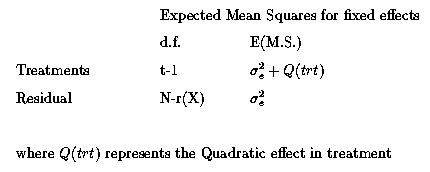
The example given in the CRD considered 6 'treatments'. These were fixed effects; we chose these 6 'treatments' and we could repeat the experiment again and use the same 6 treatments. Our results pertain only to these treatments and cannot be extrapolated to any others. In general then, with t 'treatments', or classes, and r observations, or experimental units, per class we will have the following Expected Mean Squares from our Analysis of Variance table.

Or more generally we can write this as :

Another class of effects are random effects. Suppose that we are interested in variability within and between apple trees in the weights of apples. We randomly select 6 trees (perhaps from the Macdonald orchard) and then randomly pick 4 or 5 apples per tree. Our interest is in the variability between apples within trees and between trees.
We consider, in much the same way as we consider the random errors to be sampled from a population with a mean of Zero and a residual variance, so we consider that the trees are a random, representative sample from a population of trees with a mean of Zero and a variance equal to the variance amongst trees:

So, this gives us 2 variance components:

If we analysed this dataset and looked at the Expected Mean Squares we would find :

For the fixed effects model the 8 parameters of the model are :

For the random effects model the 3 parameters of the model are :

As a general rule-of-thumb most biological organisms, particularly those that reproduce sexually and cannot be identically cloned, should be considered as random effects. This is because if we repeat the above experiment again we will have another random sample of trees, which will not be identical to the 6 trees in the first study. In addition, we wish our results to be applicable to apple trees in general, or at least those of the same variety.
In the example of a Completely Randomised Design (CRD) the sample dataset was given as coming from either 6 different diets fed to cows, or 6 different inoculants for enhancing plant production. The 6 diets for cows should be considered as fixed effects and as long as the assignment of cows to the diets is at random there is no bias and the requirements for the experimental design and subsequent analysis are met.
What about the case of the 6 different inoculants?
The inoculants are biological organisms; should they be fixed or random effects?
Well it turns out that we should consider them as fixed effects. Why?
Because we are not identifying individual organisms, only the strain, or variety, which we are considering to be a fixed, consistent, repeatable effect (of the strain). If we were to repeat the trial next year with the same 6 strain of inoculant, although the actual cells would not be exactly the same, we would still be looking for the fixed, consistent, repeatable effect of each ioculant. Thus we should consider inoculant strains as fixed. Another reason why they should be considered as fixed is that we chose the 6 strains.
If we had randomly picked 6 strains from a large pool of possible strains, and we were not interested in identifying actual strain effects, but only in quantifying the amount of variability between strains then we could have considered strain to be a random effect.
Thus, it all depends upon your experimental design. The factor that you are looking at; did you choose the particular levels (diets, strains, etc) to look at those specific levels (FIXED), or did you have a random sample of levels (diets, strains, apple trees, etc) so that you could make broad, general statements about the variability between diets, strains, apple trees, etc, without wanting to estimate the specific effect of the particular levels you happened to have?
References:
Steel, R.G.D., Torrie, J.H., and Dickey, D.A. 1997. Principles and Procedures
of Statistics. A Biometrical Approach. 3rd edition.
McGraw-Hill Publishing. Chapter 7, section 7.5 The Linear Additive Model.
Searle, S.R. 1971. Linear Models. John Wiley and Sons.
Cochran, W.G., and Cox, G.M. 1957. Experimental Designs. John Wiley
and Sons.
